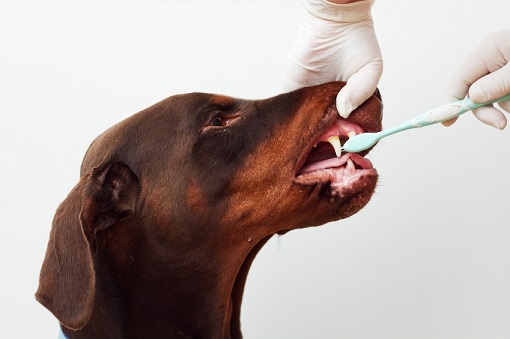
I'm taking my 11-year-old cat Beamer to the vet on Friday to have his mouth examined. The poor guy has some gross-looking teeth that might be causing him pain. Had I taken his dental care more seriously while he was younger, I could've prevented some of his current discomfort.
February is National Pet Dental Month, according to the American Veterinary Medical Association, and I'm writing this to encourage other pet owners to do what they can to keep their pets' teeth and gums clean and healthy.
Pet Dental Care
Do dogs and cats get cavities?
Cavities are rare in pets, affecting less than 5% of all dogs and even fewer cats, according to Dr. Jules Benson, vice president of veterinary services at Petplan pet insurance.
"We’re beginning to see more cavities in pets fed high-sugar treats," he said. "If you share 'people food' with your pets, choose super foods like lean meats, fish, poultry and veggies – and skip starches and sweets."
Broken teeth
Benson said a more common problem in pets, especially dogs, are fractures of the teeth from chewing very hard items.
"This often results in exposure of the inner layers of the tooth, a similar process to how our teeth feel if they have deep cavities," he said. Unfortunately, many pets eat and play as usual despite the "excruciating pain associated with nerve exposure."
The good news, however, is that chipped "chompers" can be treated with extraction, according to Benson.
Periodontal disease
"Periodontal disease is a very serious problem as it can lead to many more serious conditions in our dogs and cats," said Dr. Jeff Werber, owner of Century Veterinary Group in Los Angeles.
He said the disease is extremely common and affects about 75% of dogs and cats over age 3. Once it progresses, periodontal disease can lead to:
- severe gingivitis (gum inflammation)
- bone destruction
- tooth loss
Oral bacteria is more prevalent in dogs and cats with periodontal disease, he said. This bacteria can "enter the blood stream and colonize in many key organs, like the heart, kidneys, and liver, leading to serious complications."
How to prevent periodontal disease in dogs and cats
1. Daily brushing
Brushing your pet's teeth is an "essential part of maintaining healthy teeth and gums and avoiding the complications of periodontal disease," according to Werber.
Ideally, he recommends pet owners brush their pets' teeth daily using any readily available tooth kits such as the ProSense home dental kit.
"But, as I tell my clients, if they do it two to three times a week, I’ll still be thrilled!" he said.
While my Lab mix Ace will tolerate having his teeth brushed, my cats are another story so I asked Werber for some suggestions.
"I at least recommend that cat parents do their best to try," he said.
He recommends cat dental kits with fish- or poultry-flavored toothpaste. He also recommends small, soft-bristle toothbrushes or a small, finger brush.
"Start slowly, always before a meal or a treat, and make it as enjoyable as possible," he said.
2. Appropriate treats and chews
Certain dental chews, toys and treats can help control plaque and tartar buildup, Werber said. He recommends these along with regular brushing, and if brushing fails there are also oral antiseptic gels and water additives.
These can help "control oral bacteria and help prevent tartar accumulation," he said.
DogIDs carries a variety of health products, which is designed to reduce a dog's bad breath. Rawhides and other chews are another good option.

3. Regular vet exams and professional cleanings
Dental health is one of the most important “routine” health issues for our pets, according to Benson. He said we should ask our pets' veterinarians about how often each unique pet may need professional cleaning under anesthesia.
For example, my dog Ace (8 years old) and my cat Scout (9 years old) seem to have fairly healthy teeth and gums. According to their vet, a professional cleaning is not necessary at this point. However, this is not the case for my cat Beamer (pictured).
According to Benson, a professional cleaning allows a complete exam of the pet’s mouth, and it allows the vet access to clean the areas below the gumline that you can’t see, but where plaque and bacteria buildup are most damaging.
The cost for this procedure is not cheap. According to the vet, the cost of a cleaning starts at $413, and that does not include x-rays or extractions, which he will most likely need.
So, while I'm lucky there are veterinarians who can help guide me in treating my cat's dental problems, it would've been easier (or at least less expensive!) had I been brushing his teeth all along.
If you can manage to get into the habit of brushing your pet's teeth even once a week, it could make all the difference.
Let me know your thoughts.
Do you brush your dog or cat's teeth?

